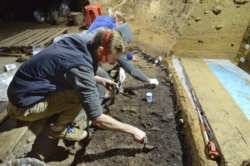Human bones from Bulgaria suggest human beings first arrived in Europe thousands of years earlier than previous studies have shown. This means humans shared the continent with Neanderthals, our closest relative, much longer than experts had believed.
Scientists studied four pieces of bone and a tooth. Detailed radiocarbon and genetic testing show they came from four Homo sapiens, the oldest of which is dated to about 46,000 years ago.
Two separate reports on the study appear in the scientific publications Nature and Nature Ecology & Evolution.
Helen Fewlass was a lead author of one of the reports. She is with the Max Planck Institute for Evolutionary Anthropology in Germany.
Fewlass told The Associated Press the previous oldest European human bone pieces were found in Romania. Efforts to date these bone pieces resulted in problems, she added. But they were likely from sometime around 40,000 years ago, give or take a few thousand years. And that bone material had Neanderthal genes in it, suggesting that Neanderthals and Homo sapiens had mated about 200 or so years earlier.
The researchers said they now think Europe’s ancestors came from Africa about 47,000 years ago during a short warming period.
This means that for about 7,000 years or so, humans and Neanderthals lived on the same continent, interacting a little, but probably not so often. So says Jean-Jacques Hublin, another study lead author and the director of the Max Planck Institute.
Hublin said Neanderthals completely died out about 40,000 years ago. “We know that when … (humans) arrived, there were Neanderthals,” he noted. “The Danube Valley might have been a way for modern humans — by the way, at different periods — to move into this part of Europe.”
This early group of humans probably never made it west over the mountains known as the Alps, Hublin added. It was likely only a few hundred people and they may have died off. Modern Europeans came from a second later wave of humans out of Africa, he said .
The remains were found in Bulgaria’s Bacho Kiro cave, which has been open to scientists and the public since 1930. The cave is hard to reach and contains animal bones, including those of a rhinoceros and lions, Fewlass said.
“How would they get into that cave … unless humans brought parts of the animal, the body, into the cave?” she asked.
Researchers have recovered a large amount of bones from cave bears. These early Europeans made jewelry out of cave bear bones, not other animals, showing a connection to the bears, Hublin said.
He added that the discovery suggests Neanderthals, who until this time period had not shown jewelry making skills, learned the skill from human beings.
The study makes a very strong argument and “greatly strengthens the hypothesis that modern humans dispersed into Europe before 45,000 years ago from Western Asia,” said Katerina Harvati. She is a paleoanthropologist at the University of Tuebingen. She was not involved in the study.
Harvati agreed with Hublin that it is likely that Neanderthal jewelry found in Western Europe was something that species somehow learned from humans. Other researchers praised the dating of the newly found bones. But they said they were unsure about whether the teaching of skills did happen.
I’m Pete Musto.
Seth Borenstein reported on this story for The Associated Press. Pete Musto adapted this story for VOA Learning English. George Grow was the editor. We want to hear from you. Write to us in the Comments Section.
_______________________________________________________________
Words in This Story
previous – adj. earlier in time or order
radiocarbon – n. the scientific way of finding the age of something that is very old by measuring the amount of radioactivity in certain forms of carbon in it
author – n. a person who has written something
interact(ing) – v. to talk or do things with other people
cave – n. a large hole that was formed by natural processes in the side of a cliff or hill or under the ground
jewelry – n. decorative objects, such as rings, necklaces, and earrings, that people wear on their body
hypothesis – n. an idea or theory that is not proven but that leads to further study or discussion
disperse(d) – v. to go or move in different directions : to spread apart






